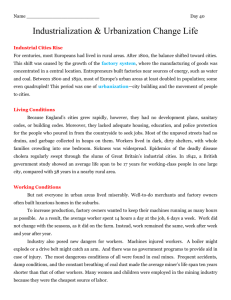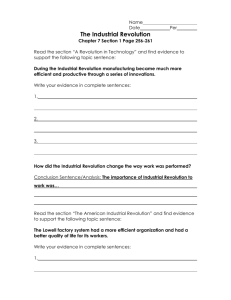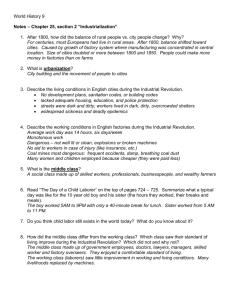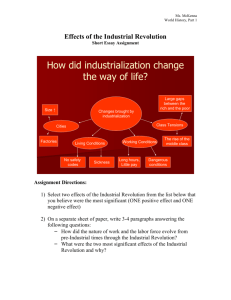Social Impacts of Industrialization
advertisement
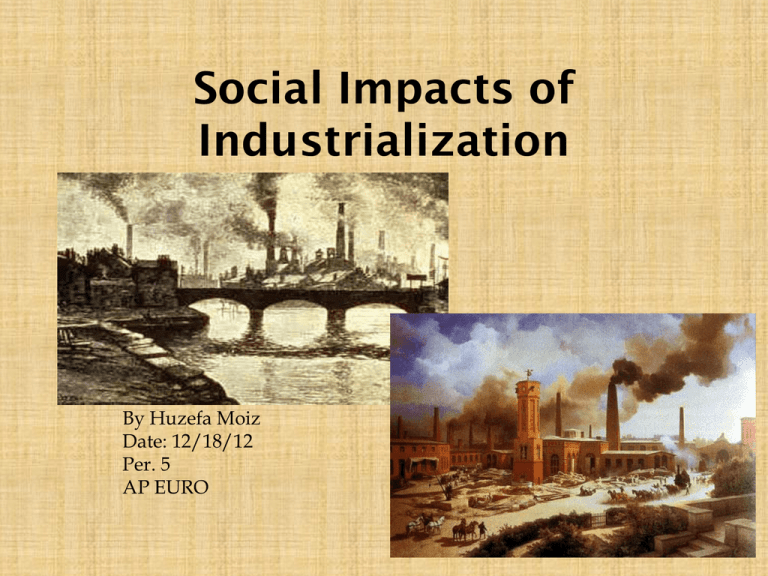
Social Impacts of Industrialization Click to edit Master subtitle style By Huzefa Moiz Date: 12/18/12 Per. 5 AP EURO The Factory The factory was seen as a symbol of the power of steam and of technology in this era of industrialization. Hundreds of employees carried out their jobs under one roof . For example, the average amount of workers in Manchester cotton factories was three hundred employees. Factories in this time period also worked to symbolize several things including the power of capital and the ability to reconstruct and reform cities at impossible speeds. Textile factories thrived in this new world because of the sheer number of workers that had previously worked on weaving and spinning at home. A large part of population was attracted to this new textile factory business. It was risky to invest in factories because of all the demands that it provides such as the need for buildings, machinery, and raw materials. As production (shown to right) increases, so does the number of factories Factory Life Factory life was brutal in the industrial revolution. Workers followed a strict schedule and started at either 5:30 or 6:00 clock in the morning and worked thereafter for 12 hours including accumulated meal times and recesses. Efficiency of these factories were disrupted by the high chance of drunkenness from workers. These workers in turn caused problems with the machines and the overall running ability of the factory. High level of drunkenness may have in part led to temperance movement Insolent behavior resulted in expensive fines which could come about from whistling, talking, or for flawed work. Sometimes foremen relied on whips to discipline the workers. Bad etiquette flowing through the workers was solely treated through more and more discipline. Also terrible pollution from exhaust, smog and chemicals from work and machines Causes high rate of diseases, especially lung (iron lung, coal lung, etc.), in factories Factory Life The masters in their crafts were able to maintain a higher standard of living in the factories. These included masons, tanners, bakers, and steam-engine makers who were the main political voice in terms of factorial reforms. Although they fought in the name of factories, they were actually referring to their own rights because they looked down upon simple factory workers. “Productive class” according to Adam Smith “Unproductive class” Their work allowed for improved conditions in factories quite significantly through legislative acts that regulated working hours and called for new codes on hygiene and safety. Differentiation Differentiation can be defined as the growth of specialization throughout groups and institutions and this was quite apparent in the 19th century. Social structure changed in that it became less relevant. For instance, governmental affairs were answered through calculation rather than through social status. This principle caused the conflicts between several aspects of the nation including national law or local custom and centralizing bureaucracies and local autonomy. The appearance of agencies came around this time and they managed governmental tasks such as collecting taxes and administering welfare. Family and Traditional Roles The importance of the family seems to have been brought up during the time of the industrial revolution and is attributed to a real response to stress. Families in Europe have always been based upon social status. The aristocracy was wealthy and tightly connected with relatives of similar social class. Father holds patriarchal stance at head of family that runs things through the family and puts food on the table Women were still seen as lesser beings, but did play a crucial role in foreign affairs. Especially those having to do with joining royal families. Peasants owned land of their own and if their estates were large enough they would share it with one of their relatives. It was also possible for other extended family members to live on nearby plots of land. The Peasant Life Children were held responsible for taking care of simpler chores such as tending the livestock. It was usually taking care of the smaller animals. Men were always occupied because of the grueling labor that they had to put up with. They were responsible for the heavier lifting and strength required jobs. Women were able to make considerable strides in their own respects. They were often able to make excess money by taking up jobs at the mill or in domestic services. Men traveled long distances to find work and these occupations usually included areas such as those at the docks, roads, and royal estates. Urban population increases dramatically Population increases led to children being forced out of their homes and sent to nearby towns and mills to be employed. The Impact of Industrialization The middle classes composed of artisans, masons, and other masters of crafting arts. Their children were often taught new trades from other masters because joining an urban life was encouraged if wages permitted. Surprisingly, fathers equipped with only pre-industrial skills stayed at home and cared for household chores while their children and wives earned wages. Women and children suffered long hours of labor and were not really close to reforms because sexual barriers did not allow this for many years to come. Benefited most from Industrial Revolution Children specifically viewed as burdens on families unless put to labor on hard jobs unadjusted to their age or ability Major social issues of the time comprised of the fear of unemployment, household conflicts, and the harsh conditions of factory and farm life. Middle-Class Women The status of women changed during this time period because they actually worked and made wages. France as compared to other countries saw lower to middle class women as possibly more important in shops and stores. There was a fine line between the middle class women and lower class women and the roles of the mother and wife signified the social status of a women. Middle class women were in a stable state in which they did not suffer from poverty or from the cruel politics of the era. Women still did not have full equality as women of all classes were obligated to clean dishes, wash clothes, and cook meals. Only those women who had servants to do these chores were free from these obligations. Moral Seriousness The occupation of a middle class women as a solitary household caretaker was highly honored. Women were responsible for the education of their children and were at the center of their elaborate training to become adults. Childhood usually lasted longer in the middle class because of the extensive training it took to become fully prepared for the world. Women of the middle class were shut off from the world and there was a lack of independence even through some reforms. Many were moved by the changes in society and a writer named Thomas Bowdler wrote a play based on a Shakespearean model describing the new family status in society. During this time there was a call for higher discipline and morality as drunkenness and prostitution had reached new levels. Living Conditions As seen previously in the past, the standard of living for the poor has always decreased when the upper and/or middle classes rises. Workers could not afford to rebel because they heavily relied on their employers to supply the small income needed to care for their families. Overcrowding was a major issue for the lower class. Towns with factories quickly filled up with people looking for work and overpopulation caused several problems. Some of these problems included sewage issues, single room houses for an entire family, and one unreliable water source for hundreds of people. Disease was a recurring problem and spread easily in mines and cotton mills where the air was unclean and inhaled by the workers everyday. Diseases such as tuberculosis spread rapidly in this time period. Living Conditions Employers usually hired around 150 to 300 workers who were easily disposed of if new and more efficient opportunities presented themselves. Bread was the center of a families diet and starvation usually followed without it because most other foods were too expensive or unavailable. About a third of the population of men in towns were unemployed and this was common during the winter. Depressions such as those in the 1840’s and 1850’s further worsened the situation of the lower class. Unemployment skyrocketed during the 1860’s due to the American Civil War and large masses of people during that time lived solely off of relief. Purchasing Power It might be surprising but some places in Europe saw a rise in their overall wages. Upper class foods such as meat and sugar became somewhat available to the lower classes and became definitely available to the middle classes, symbolizing their prosperity and overall benefit from the Industrial Revolution. Reforms in living conditions took place which included the use of soap and the wearing of cotton underwear. Brick construction and the addition of iron pipes into buildings allowed for bettering conditions of the poor. Factories of alcohol questioned whether or not to meet the demand for alcohol because of the danger of such a high percent of the population being frequently drunk. Luddites Revolts Britain dominated the Industrial Revolution, but suffered severe opposition. This was revolt in the early 19th century concerning the fall of the industrial revolution. The movement was led by General Ned Ludd and his army of redressers who adopted a moral code known as luddism. Factory owners received threats from this group and even some were murdered including William Horsfall who owned a large mill near Yorkshire. This movement took storm in England and mainly involved the destruction of factories and large mills. The government reacted swiftly and effectively by creating laws that incriminated the Luddites and by offering money in exchange for information concerning the Luddites. Reforms Due to the Industrial Revolution Several reforms arose during this period concerning factory conditions. The main reforms had to do with working hours such as the Health and Morals of Apprentices Act which called for a maximum of 12 hours of work a day and no night shifts allowed. Over time the work hours lessened and lessened and dropped to 10 hours for men. Factory Act (shown to right) By the 1840’s, children received several reforms having to do with working hours and these included a six and a half hour working day for children under thirteen. Children under age eight were not permitted to be hired. Factories were encouraged by the government because of the new form of economy called laissez-faire economics, which encouraged the individual entity to be free in the economic realm from government intervention. Bibliography “1861: The U.S. Constitution and Civil War.” | danmillerinpanama." danmillerinpanama | Dan Miller's blog. N.p., n.d. Web. 19 Dec. 2012. <http://danmillerinpanama.wordpress.com/2011/12/27/the-u-s-constitutionand-civil-war/>. Chambers, Mortimer. The Western Experience. 9th ed. New York: Knopf; [distributed by Random House, 1974. Print. "Frederick Morgan (British, 1856-1927) 19th century family gathering print | Antique Helper." Indianapolis Auctions | Antique Helper Auction House. N.p., n.d. Web. 19 Dec. 2012. <http://www.antiquehelper.com/item/341167>. "Fully Working Miniature Brass Steam Engine Coolest Gadgets." Coolest Gadgets - reporting on the latest cool gadgets . N.p., n.d. Web. 19 Dec. 2012. <http://www.coolest-gadgets.com/20061128/fully-working-miniaturebrass-steam-engine/>. "Impact of the Industrial Revolution." The Industrial Revolution. SEACA, n.d. Web. 18 Dec. 2012. "Jahsonic's microblog : Family Shakespeare by Thomas Bowdler In... ." Jahsonic's microblog . N.p., n.d. Web. 19 Dec. 2012. <http://jahsonic.tumblr.com/post/3451611744/family-shakespeare-by-thomas-bowdler-in>. "Letter from Ned Ludd to the Mythicists." Patheos | Hosting the Conversation on Faith. N.p., n.d. Web. 17 Dec. 2012. <http://www.patheos.com/blogs/exploringourmatrix/2012/04/letter-from-ned-ludd-to-themythicists.html>. Bibliography "Life as a factory worker during the Industrial Revolution.." Log in. N.p., n.d. Web. 19 Dec. 2012. <http://issworldhistory.forumotion.net/t1162-life-as-a-factory-worker-during-the-industrial-revolution>. "Russian-Classics." Russian Classics. N.p., n.d. Web. 19 Dec. 2012. <http://www.russian-classics.com/gp/gzhel.shtml>. Savill, Richard. "School bans sugar in tea - Telegraph." Telegraph.co.uk - Telegraph online, Daily Telegraph, Sunday Telegraph - Telegraph. N.p., n.d. Web. 19 Dec. 2012. <http://www.telegraph.co.uk/finance/economics/3188978/School-bans-sugarin-tea.html>. " TUBERCULOSIS TB and ART, MUSIC, DRAMA" ICONS OF EUROPE: ART MUSIC LITERATURE SCIENCE / THE VALUE OF GREAT CULTURE. N.p., n.d. Web. 19 Dec. 2012. <http://www.iconsofeurope.com/tb.htm>. "Potatoes, the fruit of the earth | vox." vox | Research-based policy analysis and commentary from leading economists. N.p., n.d. Web. 19 Dec. 2012. <http://www.voxeu.org/article/potatoes-fruit-earth>. "Webquest Task." University of Northern Iowa | University of Northern Iowa. N.p., n.d. Web. 19 Dec. 2012. <http://www.uni.edu/schneidj/webquests/adayinthelife/task.html>.century, the middle of the, women novelists were becoming distinctly more professional in their handling of their careers, and more directly involved in every stage of the publishing process" (Sanders 155). Wilkinson, Michelle. "Social Effects of the Industrial Revolution." Helium. Helium, 25 July 2008. Web. 18 Dec. 2012. "Women in the Public Sphere." Duke University Libraries - Home. N.p., n.d. Web. 19 Dec. 2012. <http://library.duke.edu/exhibits/britishwriters/womeninpublicsphere.html>. Thank You I’d like to thank you for looking at my presentation even if I do get a zero on it. I think it is a helpful tool because it summarizes my section pretty well and tells the viewpoints of the different classes of society during the Industrial Revolution. Once again thank you for taking the time to look at my presentation.


